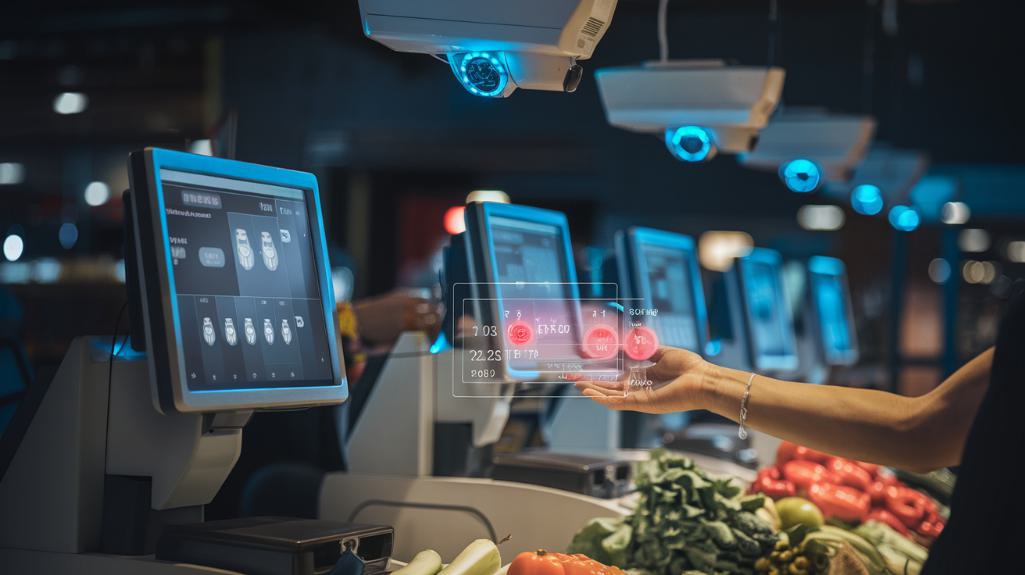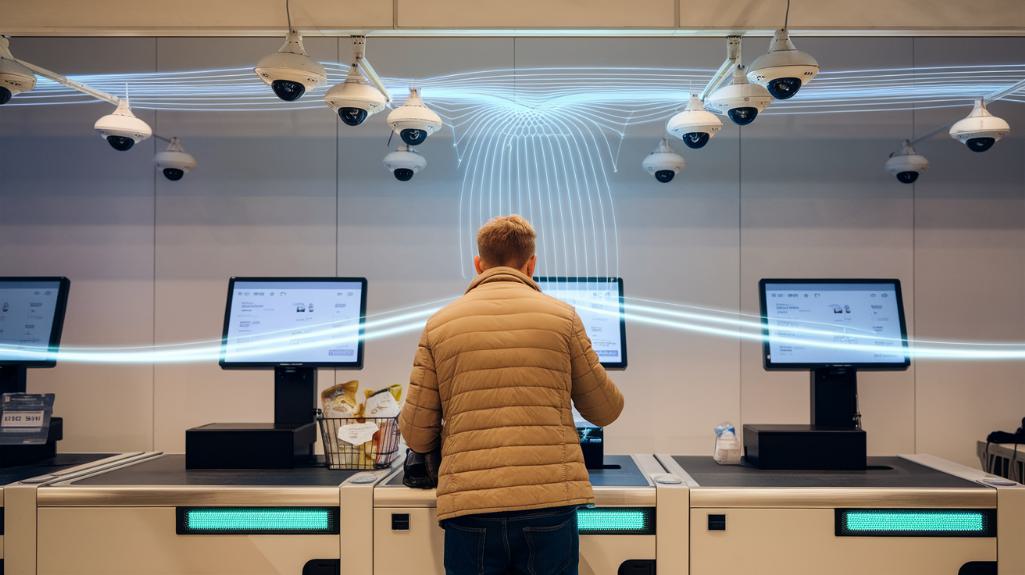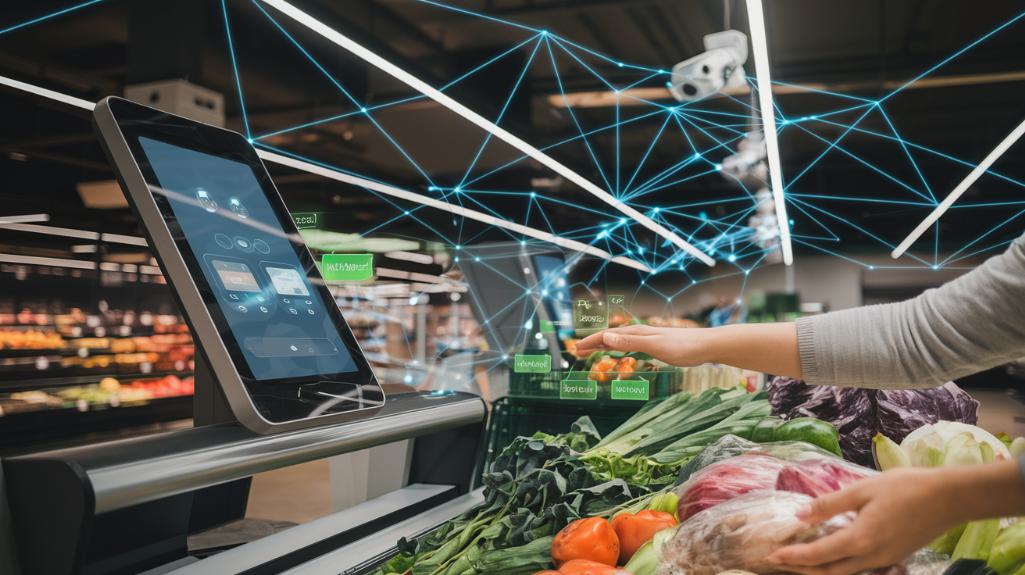Retailers are combating scan avoidance fraud through AI-powered checkout monitoring systems that utilize computer vision and machine learning algorithms. These systems analyze real-time transaction data and video feeds to detect suspicious behaviors, particularly during high-risk evening hours when staffing is reduced. Advanced cameras integrated with point-of-sale systems instantly alert security personnel to potential theft patterns. The technology has proven effective in reducing inventory shrinkage while maintaining a frictionless customer experience, with multiple deployment strategies emerging across the retail sector.
Key Takeaways
- AI-powered cameras and computer vision systems monitor customer behavior at self-checkout stations to detect unscanned items in real-time.
- Machine learning algorithms analyze transaction patterns and compare visible products with scanned items to identify suspicious activities.
- Real-time alert systems immediately notify loss prevention teams when potential scan avoidance is detected, enabling swift response.
- Continuous monitoring focuses on high-risk periods, particularly after 8 p.m. when scan avoidance peaks due to reduced staffing.
- Integration of AI with POS systems provides data-driven insights to optimize loss prevention strategies while maintaining smooth customer experience.
Understanding the Rise of Scan Avoidance in Retail

As retailers increasingly adopt self-checkout technologies to address labor challenges, scan avoidance has emerged as a significant security concern affecting approximately 20% of transactions.
This rise in deliberate non-scanning behaviors has prompted retailers to implement advanced theft detection systems and enhanced loss prevention strategies.
Analysis of scan avoidance patterns reveals heightened risk during specific timeframes, particularly after 8 p.m., when staff oversight may be reduced.
Retail scan avoidance peaks during evening hours when fewer staff members are present to monitor self-checkout systems.
To combat these losses, retailers are deploying AI models that systematically compare visible products with scanned items, identifying suspicious behaviors in real-time.
This data-driven approach enables security teams to focus resources efficiently, adjusting staffing levels and modifying self-checkout configurations in areas demonstrating higher incidents of theft.
The integration of video analytics further strengthens retailers' ability to detect and prevent scan avoidance systematically. Additionally, implementing AI-driven learning allows the system to continuously adapt to new theft techniques, enhancing overall loss prevention efforts.
The Technology Behind AI Checkout Monitoring Systems
Modern AI checkout monitoring systems represent a sophisticated fusion of computer vision, machine learning, and point-of-sale integration technologies. These systems deploy advanced computer vision algorithms to analyze transaction behaviors and detect potential fraud and theft in real-time, while seamlessly integrating with existing POS systems for thorough monitoring.
Key technological components include:
- Computer vision sensors that track customer movements and item handling during checkout
- Machine learning algorithms that continuously analyze transaction patterns and flag suspicious activities
- Real-time alert systems that instantly notify loss prevention teams of potential theft
The technology's analytical capabilities extend beyond immediate detection, enabling retailers to identify behavioral trends and peak risk periods. This data-driven approach allows for strategic adjustments to loss prevention protocols, enhancing overall security effectiveness across retail operations. Additionally, the incorporation of AI-driven object recognition helps ensure accurate item counting, further mitigating risks associated with checkout fraud.
Real-Time Detection and Response Strategies
Through real-time monitoring of self-checkout stations, AI-powered detection systems continuously analyze both transaction data and video feeds to identify potential fraud instantly.
The integration of advanced cameras with transaction processing enables loss prevention teams to detect suspicious activities as they occur, particularly during high-risk periods after 8 p.m.
When the system identifies patterns indicative of retail crime, such as scan avoidance or irregular scanning behaviors, it generates immediate alerts for security personnel to investigate.
This swift response capability allows retailers to address potential theft situations before significant losses occur.
Balancing Customer Experience With Loss Prevention

While implementing robust security measures remains essential for retail operations, maintaining a frictionless customer experience presents a delicate balancing act for retailers.
Modern loss prevention strategies leverage AI technology to achieve this equilibrium while addressing the significant challenge of scan avoidance fraud.
Successful retailers optimize their security approach through:
- Data-driven staffing adjustments during high-risk periods to maintain efficient customer flow
- AI-powered video analytics that identify suspicious transactions without disrupting legitimate shoppers
- Strategic deployment of self-checkout stations balanced with informed business decisions about peak usage times
This integrated approach enables retailers to reduce their 1-3% inventory shrinkage while preserving customer satisfaction. Additionally, utilizing advanced AI capabilities can further enhance operational efficiency and customer experience.
Measuring the Impact of AI on Shrinkage Reduction
Retailers implementing AI-powered checkout monitoring systems report measurable reductions in inventory shrinkage, with data indicating that scan avoidance patterns can be reduced by targeting the 20% of shoppers who admit to checkout fraud. The return on investment becomes evident as retailers leverage AI analytics to identify high-risk transactions and optimize loss prevention staffing, particularly during periods of increased theft activity. These systems demonstrate their value by addressing the 1-3% revenue loss from shrinkage, effectively making the technology self-funding while providing actionable data for continuous security improvements. Additionally, the integration of AI-driven analytics enhances the ability to detect and prevent fraudulent behavior at checkout.
ROI From AI Implementation
Measuring the Return on Investment (ROI) from AI-powered checkout monitoring systems reveals compelling evidence of their financial impact on retail operations.
These artificial intelligence solutions demonstrate significant value through enhanced inventory management and theft prevention capabilities.
Key ROI indicators include:
- Shrinkage reduction of 1-3% of total revenue through improved scan avoidance detection
- Operational efficiency gains from data-driven resource allocation and automated monitoring
- Cost recovery through real-time alert systems that enable immediate intervention
The implementation of AI-powered monitoring systems consistently proves self-funding through loss prevention.
By utilizing advanced analytics to identify theft patterns and suspicious transactions, retailers can optimize their security protocols while maintaining streamlined operations.
This systematic approach to loss prevention delivers measurable financial benefits while strengthening overall store security posture.
Loss Prevention Success Metrics
Tangible performance indicators demonstrate the effectiveness of AI-powered checkout monitoring systems in reducing retail losses. Key metrics reveal shrinkage reductions of up to 30% within the first year of implementation, while scan avoidance detection rates improve by 20% in self-checkout environments.
AI systems analyzing transactions in real-time have increased suspicious activity detection by 40%, enabling swift intervention in potentially fraudulent scenarios.
Loss prevention teams leverage these metrics alongside false positive rates to optimize system accuracy and response protocols. Integration with existing POS infrastructure provides thorough transaction monitoring capabilities, allowing retailers to track and measure specific improvements in checkout accuracy.
This data-driven approach enables continuous refinement of prevention strategies, resulting in measurable reductions in financial losses and enhanced operational efficiency.
Best Practices for Implementing AI Checkout Solutions
While deploying AI checkout monitoring systems represents a significant technological advancement, successful implementation hinges on several critical best practices. Effective integration with existing POS systems enables real-time monitoring and swift response to suspicious activities. Loss prevention teams can leverage AI analytics to identify suspicious patterns and intervene promptly when needed.
Key implementation requirements include:
- Seamless integration of AI solutions with current POS infrastructure to guarantee uninterrupted transaction monitoring.
- Regular updates to machine learning algorithms based on emerging fraud patterns and new data inputs.
- Thorough staff training programs focusing on AI-generated insights and appropriate response protocols.
Success depends on maintaining peak system performance through continuous assessment and refinement of AI models while making certain loss prevention teams can effectively utilize the generated insights. Additionally, real-time consumer behavior insights from AI systems can enhance the effectiveness of fraud detection strategies.
Frequently Asked Questions
Can AI Checkout Systems Work Effectively in Stores With Poor Internet Connectivity?
Modern checkout systems employ offline functionality and data caching to maintain system reliability. Local user interface operations continue while connectivity solutions guarantee data synchronization when internet access becomes available.
What Are the Initial Costs of Implementing AI Checkout Monitoring Systems?
Initial investment considerations include hardware procurement costs ranging $10,000-50,000 per lane, software licensing fees, integration with existing systems, and ongoing maintenance expenses for thorough checkout monitoring implementation.
How Long Does Staff Training Typically Take for AI Monitoring Systems?
Initial staff training duration ranges from 2-4 weeks, covering technology adaptation and fraud detection protocols. Ongoing staff engagement guarantees operational efficiency through quarterly refresher sessions and system updates.
Do Weather Conditions Affect the Accuracy of AI Checkout Monitoring Cameras?
Weather impact on monitoring cameras primarily affects outdoor variability and seasonal effects. Camera performance may deteriorate during extreme conditions, while indoor lighting conditions remain relatively stable and controlled.
Can Customers Opt Out of AI Monitoring While Using Self-Checkout Stations?
Most retailers do not offer opt-out options due to security protocols, though privacy concerns persist. Customer consent and ethical implications regarding technology transparency remain debated aspects affecting the overall user experience.
Conclusion
AI-powered checkout monitoring represents a critical evolution in retail loss prevention. By combining computer vision, machine learning, and real-time analytics, retailers can effectively detect and prevent scan avoidance while maintaining operational efficiency. As these systems continue to mature, their integration with existing security frameworks will be essential for sustainable shrinkage reduction and enhanced store profitability. Success depends on strategic implementation and continuous system optimization.


